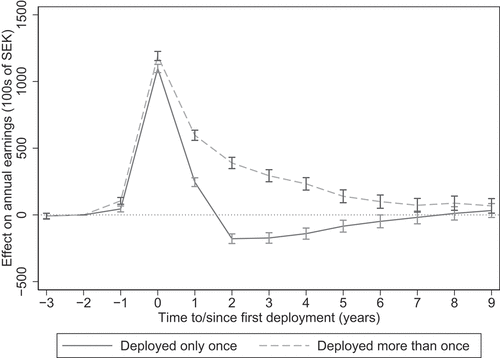Figures & data
Figure 1. Number of deployments in the sample, by deployment year, and the distribution of deployments across geographical locations. The sample consists of 11,279 former conscripts who underwent enlistment testing (and subsequently initiated their conscription service) in Sweden during 1990–2010 and who were deployed to an international peace mission (for the first time) at some point during 1993–2010.

Figure 2. Observed annual earnings for the veterans and their potential controls from the same birth-cohort. Average annual earnings in 100s of SEK, in 2019 prices, for veterans deployed for the first time 1993–2010, and a comparison group of non-veterans matched by birth-cohort and calendar year of observation only. Year 0 refers to the calendar year when a veteran was deployed for the first time. 100 SEK is approximately $10, £8 or €10.
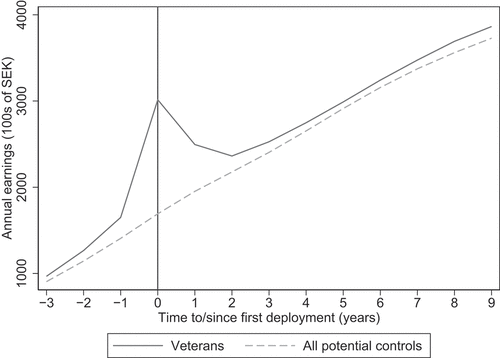
Table 1. Descriptive averages.
Figure 3. Observed annual earnings for veterans and the matched comparison group of non-veterans. Average annual earnings in 100s of SEK in 2019 prices for veterans deployed for the first time 1993-2010 and the matched comparison group of non-veterans. Year 0 refers to the calendar year when a veteran was deployed for the first time. 100 SEK is approximately $10, £8 or €10.
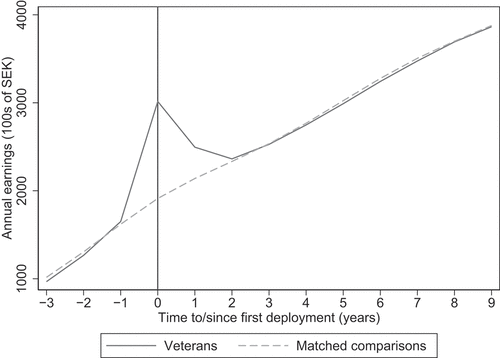
Figure 4. Impact of deployment on average annual earnings. Matched difference-in-differences estimates of the average treatment effect from first-time deployment 1993–2010 on veterans’ annual earnings (100s of SEK in 2019 prices) for up to nine years after deployment. Error bars represent 95% confidence intervals. Year 0 refers to the calendar year when a veteran was deployed for the first time. Baseline year is year − 2. 100 SEK is approximately $10, £8 or €10.

Figure 5. Impact of deployment on average annual earnings, by military mission. Matched difference-in-differences estimates of the average treatment effect from first-time deployment to various missions on veterans’ annual earnings (100s of SEK in 2019 prices) for up to nine years after deployment. Estimates for veterans from Bosnia (1992–1999), Kosovo (1999–2010) and Afghanistan (2002–2010). Error bars represent 95% confidence intervals. Year 0 refers to the calendar year when a veteran was deployed for the first time. The baseline year is year − 2. 100 SEK is approximately $10, £8 or €10.
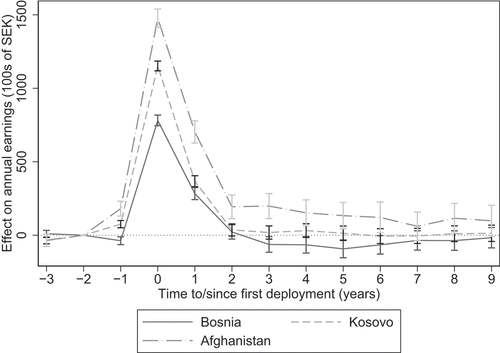
Figure 6. Impact of deployment on average annual earnings, by groupings of deployment years. Matched difference-in-differences estimates of the average treatment effect from first-time deployment on veterans’ annual earnings (100s of SEK in 2019 prices) for up to nine years after deployment. Error bars represent 95% confidence intervals. Year 0 refers to the calendar year when a veteran was deployed for the first time. The baseline year is year − 2. 100 SEK is approximately $10, £8 or €10.
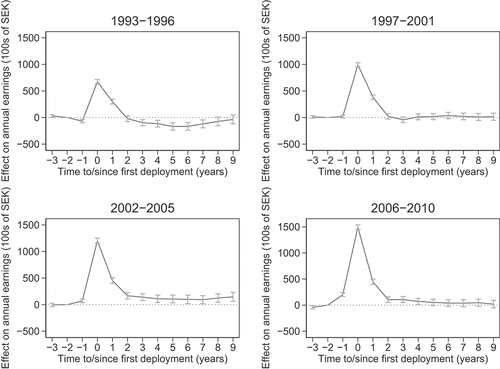
Figure 7. Impact of deployment on average annual earnings, by cognitive ability. Matched difference-in-differences estimates of the average treatment effect from first-time deployment on veterans’ annual earnings (100s of SEK in 2019 prices) for up to nine years after deployment. Average cognitive ability represents a stanine score of 5. Error bars represent 95% confidence intervals. Year 0 refers to the calendar year when a veteran was deployed for the first time. The baseline year is year − 2. 100 SEK is approximately $10, £8 or €10.
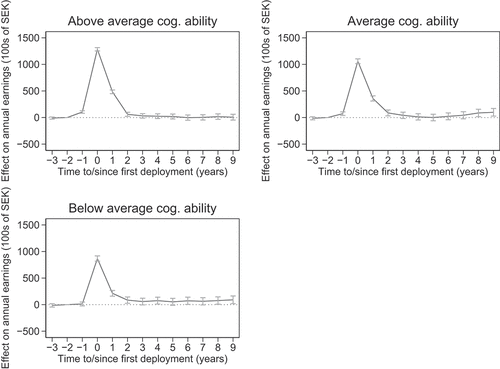
Figure 8. Impact of deployment on average annual earnings, by parents’ education level. Matched difference-in-differences estimates of the average treatment effect from first-time deployment on veterans’ annual earnings (100s of SEK in 2019 prices) for up to nine years after deployment. Individuals with at least one parent with postsecondary education (three years or longer) vs. individuals whose parents had no postsecondary education (three years or longer). Error bars represent 95% confidence intervals. Year 0 refers to the calendar year when a veteran was deployed for the first time. The baseline year is year − 2. 100 SEK is approximately $10, £8 or €10.
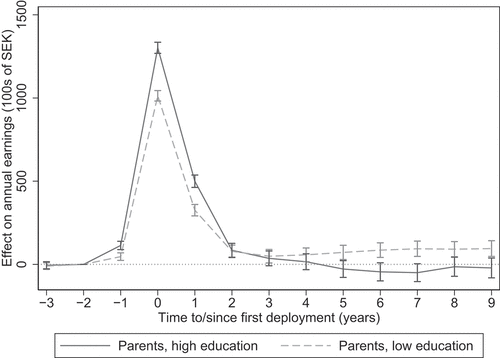
Table A1. Definitions of variables.
Table A2. Logit model estimation of the probability of deployment to a peacekeeping mission 1993–2010, conditional on observed baseline characteristics.
Table A3. The impact of deployment on annual earnings five and nine years after deployment using different matching algorithms and baseline year.
Figure A1. Distributions of the propensity-scores before and after matching. Kernel density estimates of the distribution of the propensity-score before and after matching. Treated individuals are veterans deployed for the first time 1993–2010.

Figure A2. Impact of deployment on average annual earnings, by number of deployments. Matched difference-in-differences estimates of the average treatment effect from first-time deployment on veterans’ annual earnings (100s of SEK in 2019 prices) for up to nine years after deployment. Error bars represent 95% confidence intervals. Year 0 refers to the calendar year when a veteran was deployed for the first time. The baseline year is year − 2. 100 SEK is approximately $10, £8 or €10.
